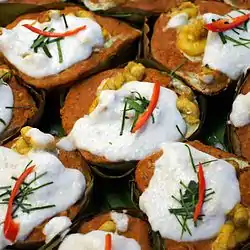Curry al vapor
Curry al vapor (en camboyano, អាម៉ុក, amŏk, aːmok; en tailandés, ห่อหมก, ho mok, hɔ̀ː.mòk, en lao, ຫມົກ, mok, mók) es un sudeste asiático tipo de curry cocido al vapor en plátano hojas. La base del curry se hace con una pasta de curry (en camboyano, គ្រឿង, kroeung, krɨəŋ; en tailandés, พริก แกง, prik gaeng) y crema de coco o leche de coco. También se agrega al plato una amplia gama de hojas e ingredientes básicos, como:
- pez (en camboyano, អាម៉ុកត្រី, amŏk trei, aːmok trəj; en tailandés, ห่อหมก ปลา, ho mok pla, hɔ̀ː.mòk plāː; en lao, ຫມົກປາ, mok pa, mók paː);
- bambú brotes (en tailandés, ห่อหมก หน่อไม้, ho mok no mai, hɔ̀ː.mòk nɔ̀ː máːj; en lao, ຫມົກຫນໍ່ໄມ້, mok ni mai, mók nɔ̄ː mâj (a menudo con carne picada adentro));
- pollo (en tailandés, ห่อหมก ไก่, ho mok kai hɔ̀ː.mòk kàj );
- caracoles (en camboyano, អាម៉ុកខ្យងរី, amŏk khyâng, aːmok kʰjɑːŋ)
- tofu (en tailandés, ห่อหมก เต้าหู้, hɔ̀ː.mòk tâw.hûː );
- huevo (en lao, ຫມົກ ໄຂ່, mók kʰāj (a menudo con carne picada adentro));
- algas (en lao, ຫມົກ ໄຄ, mók kʰáj (con Cladophora)).
| Curry al vapor | ||
|---|---|---|
 Curry de pescado al vapor tailandés (ho mok pla) en Chiang Mai, Tailandia | ||
| Tipo | Curry | |
| Procedencia | Camboya [1][2][3] o Tailandia[4] | |
| Ingredientes | pasta de curry, crema de coco o leche de coco | |
| Distribución | Sudeste de Asia | |
Según la antropóloga cultural Penny Van Esterik, los curries a base de coco del sudeste asiático son el resultado de la Indianización, que en el siglo XV después de la Caída de Angkor, se introdujeron en Reino de Ayutthaya por Khmer royal cocineros y luego reintroducido en Camboya. Hoy en día, se consideran características de las cocinas individuales del sudeste asiático.[5]
Referencias
- Alford, Jeffrey; Duguid, Naomi (2000). Hot Sour Salty Sweet: A Culinary Journey Through Southeast Asia. Workman Publishing Company. p. 180. ISBN 978-1579-6511-4-5. «Steaming fish or chicken with aromatics in banana leaf packets is a technique found from Yunnan to Cambodia. The technique is mawk in modern Thai, Lao, and Khmer, and the word and technique may originally be Khmer. »
- «Michelin-starred chef David Thompson explains his growing love for Cambodian cuisine». Aqua Expeditions. June 13, 2019. Consultado el 26 de mayo de 2021. «If the description of fish amok sounds like Thai cuisine (arguably the most popular Southeast Asian cuisine in the world), that’s because many elements of today’s Thai cooking was influenced by Khmer cooking techniques and principles perfected over centuries. (...) A dish that exemplifies Khmer influence, is fish amok, a steamed snakehead fish curry that is redolent of lemongrass, galangal and coconut aromas. »
- Mouritsen, Ole G.; Styrbæk, Klavs (2021). Octopuses, Squid & Cuttlefish: Seafood for Today and for the Future. Springer Publishing. p. 193. ISBN 978-3-030-58026-1. «The Cambodian national dish, amok, variations of which are found as mok in Laos and ho mok in Thailand, is an exceptionally delicious dish, which dates back to the royal Cambodian Angkor-Khmer kitchen. »
- Lees, Phil (25 de mayo de 2007). «The Dish: Fish Amok». The Wall Street Journal. Consultado el 7 October 2019. «The origins of fish amok are a source of regional debate. Dishes of this kind aren't unique to Cambodia. Malaysia and Indonesia boast the similar otak otak and Thailand cooks a spicier hor mok but neither nation embraces them with the passion of Cambodia. "Amok" in the Cambodian language, Khmer, only refers to the dish whereas in Thai, "hor mok" translates as "bury wrap," suggesting amok may have come from Cambodia's neighbor. »
- Van Esterik, Penny (2008). Food Culture of Southeast Asia. Greenwood Press. p. 15. ISBN 978-0-313-34419-0. «Indianization brought the coconut-milk style of Southeast Asian curries to Burma; curries once popular only in the courts are now considered to be characteristic of particular national cuisines. Indianization continued indirectly in the fifteenth century as Khmer cooks brought Indian-style coconut-based curries and boiled red and white sweets, used in Brahmanstyle rites of passage from Angkor Wat to Ayuttaya, and reintroduced them back into Khmer palace kitchens as Siamese armies ravaged parts of Cambodia. »